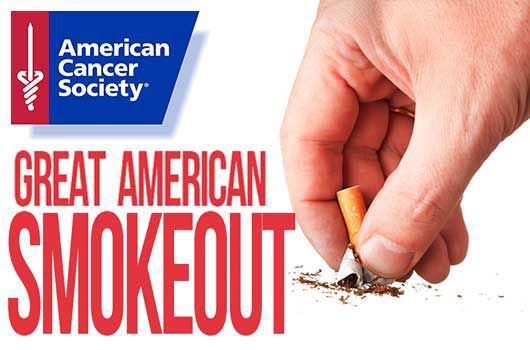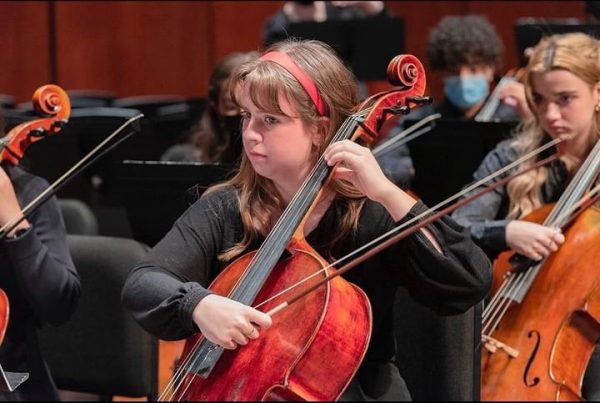Teacher puffs away old habit
Smokeout urges smokers to put out their cigarettes.

Nov. 15 is the day where smokers can take the first step to quitting, the Great American Smokeout is a time of support for all of those addicted to nicotine.
November 15, 2018
When math teacher Ellen Lloyd started college at Southwestern University, she also started smoking.
“Back then we didn’t know about the health hazards,” she said. “It was just kind of the thing to do and a lot of kids were doing it, I guess. Unfortunately I got hooked on it.”
For 16 years, she continued the habit, buying packs of cigarettes and puffing on them to satisfy her addiction. Finally the headaches from the nicotine and additives drove her to quit.
“As well as the expense, it was expensive,” Lloyd said, “but I woke up one morning, and I had such a horrible headache and I thought, ‘One of us has got to go, and it’s not gonna be me.’”
To battle against the craving and addiction of the cigarettes, Lloyd exercised or played her guitar instead of smoking. She quit on July 5,1980.
Former smokers and the American Cancer Society urge current smokers not to light up during the Great American Smokeout today.
“I think [the smokeout] is great,” Lloyd said. “If more people could stop smoking it would be a lot healthier. I could see the difference in my complexion, and in my skin.”
The establishment of the Great American Smokeout acted as a domino effect; a little push of action cascaded the movement that we know today.
In 1970, a man named Arthur P. Mullaney organized a localized event in Randolph, Mass. This event encouraged smokers to completely remove cigarettes from their lives for a day while also allowing smokers to hand over money that would typically pose as the access point towards receiving daily cigarettes. From there, the accumulated money was transformed to a scholarship fund for a high school student.
Later on in 1974, an editor of a newspaper in Minnesota penned a day in the state dedicated to not smoking, known as the D-Day/Don’t Smoke Day. However, the date Nov. 18, 1976 in California was critical in that the first true Smokeout occurred. After the success of almost 1 million participants, the event eventually became adopted nationwide, courtesy of the American Cancer Society.
The Great American Smokeout is now celebrated the third Thursday of November each year. This day acts as a first step to stop smoking in the lives of many.
Statistics of Smoking
According to CDC tobacco is largest most leading cause of preventable death in Americans. Cigarette smoking kills nearly 500,000 people each year. Second hand smoking kills 41,000 of the 480,000. In 2016 only 15.5% of americans smoked, In 2018 it has increased to 20.9%. In those two years 5.4% of the population has picked up a smoking habit.
| Race/Ethnicity | Prevalence |
| American Indian/Alaska Natives (non-Hispanic) | 31.8% |
| Asians (non-Hispanic) | 9.0% |
| Blacks (non-Hispanic) | 16.5% |
| Hispanics | 10.7% |
| Multiple Races (non-Hispanic) | 25.2% |
| Whites (non-Hispanic) | 16.6% |
| Sex | Prevalence |
| Men | 17.5% |
| Women | 13.5% |
| Age | Prevalence |
| 18–24 years | 13.1% |
| 25–44 years | 17.6% |
| 45–64 years | 18.0% |
| 65 years and older | 8.8% |
| Education Level | Prevalence |
| Less than high school | 24.1% |
| GED | 40.6% |
| High school graduate | 19.7% |
| Some college | 18.9% |
| Associate degree | 16.8% |
| Undergraduate degree | 7.7% |
| Graduate degree | 4.5% |
| Income Status | Prevalence |
| Below poverty level | 25.3% |
| At or above poverty level | 14.3% |
Michelle Price, a sophomore English teacher, has been smoking for almost 19 years. “It was the cool thing to do,” Price said. “I wasn’t a drinker, so I would sit there and I would smoke cigarettes and I’d get like a cool little buzz. That only lasted the first week, and then I became a smoker.”
When Price moved out for college, she remembers feeling a sort of freedom. “I could do it whenever I wanted.” Price said. “I wasn’t pressed to ‘This is my only free time, let’s smoke a cigarette.’ So I would smoke whenever.”
She smoked throughout college, but unexpected news briefly ended the addiction. “As soon as I found out that I was pregnant, I quit. I think I probably went about two years without smoking.”
The habit of smoking is easy to fall back into. “I smoked half a cigarette, and I remember feeling sick to my stomach, and that was when I picked it up again.” Price said. “I was just like, ‘Screw it, it is what it is.’ I have tried quitting several times since. I usually smoke a cigarette in the morning with my coffee, and then that’s it for the day. It’s gotten to the point where I’m good with the one cigarette, maybe not even. But I am a huge advocate, I tell people all the time, don’t do it. It’s going to control your life.”
Price is participating in the smokeout, to take a day to stop smoking.
Second Hand Smoking
Second hand smoking has been proven to be worse for your health than smoking itself. Not only does it it give you a greater chance of developing things such as cancer, but kids who are exposed to it are more likely to smoke once they become an adult.
“When kids are exposed to it, it can cause ear infections, severe asthma attacks, respiratory infections, and a greater risk of SIDS,” says Smithson Valley nurse, Natalie Kuhn. “Ways to avoid it is stay away from people who smoke, don’t allow people to smoke in your car, even with the windows down, and try to find public places that don’t allow smoking.”
There are many teens at this school, who are exposed to secondhand smoke, due to family members who smoke. “I’ve been exposed to it my entire life,” says sophomore Chloe Presley-Gundaker. “It’s gotten to the point where I can’t even smell it anymore.”
Healing After Smoking
The negative effects of smoking reach far and wide. A multitude of cancers, like lung, throat, mouth, and bladder stem from the act, overall accounting for the majority of cancer-related deaths in the US. Problems with fertility, diabetes, eye issues, immunity defects, frail bones, along with heart problems can arise from smoking as well.
Just twenty minutes after the last smoke, blood pressure drops and the body starts to regain circulation. Within twenty four hours after quitting, risk for heart disease decreases and oxygen levels rise, making physical activity easier. After a year of not smoking, the risk of heart disease has depleted by half. After ten years, the chances of developing lung, throat, and pancreatic cancer have all significantly been reduced, once the twenty year mark has been reached, the body is back to that of someone who has never smoked in their life.
The Struggle
Michelle Price, a sophomore English teacher, has been smoking for almost 19 years. “It was the cool thing to do,” Price said. “I wasn’t a drinker, so I would sit there and I would smoke cigarettes and I’d get like a cool little buzz. That only lasted the first week, and then I became a smoker.”
When Price moved out for college, she remembers feeling a sort of freedom. “I could do it whenever I wanted.” Price said. “I wasn’t pressed to ‘This is my only free time, let’s smoke a cigarette.’ So I would smoke whenever.”
She smoked throughout college, but unexpected news briefly ended the addiction. “As soon as I found out that I was pregnant, I quit. I think I probably went about two years without smoking.”
The habit of smoking is easy to fall back into. “I smoked half a cigarette, and I remember feeling sick to my stomach, and that was when I picked it up again.” Price said. “I was just like, ‘Screw it, it is what it is.’ I have tried quitting several times since. I usually smoke a cigarette in the morning with my coffee, and then that’s it for the day. It’s gotten to the point where I’m good with the one cigarette, maybe not even. But I am a huge advocate, I tell people all the time, don’t do it. It’s going to control your life.”















